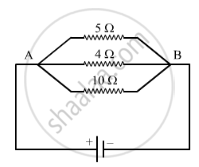Advertisements
Advertisements
प्रश्न
In the circuit diagram given below, the current flowing across 5 ohm resistor is 1 amp. Find the current flowing through the other two resistors.

उत्तर
Given I = 1 A (Across 5 Ω)
R = 5 Ω
The potential drop across AB, V = I x R
or V = 5 Ω x 1 A = 5 V
In a parallel circuit, the potential difference across the ends of all resistors remains the same. Therefore, the potential difference across 4 Ω and 10 Ω will be 5 V:
The current flowing through the 4 Ω resistor, I = V/R.
Here, V = 5 V
R = 4 Ω
So, I = 5/4 = 1.25 A
The current flowing through the 10 Ω resistor, I = V/R.
Here, V = 5 V
R = 10 Ω
So. I = 5/10 = 0.5 A
APPEARS IN
संबंधित प्रश्न
Name a device that helps to maintain a potential difference across a conductor.
How much energy is given to each coulomb of charge passing through a 6 V battery?
By what other name is the unit joule/coulomb called?
Which device is used to measure p.d?
What is a voltmeter?
Name a device which helps to maintain potential difference across a conductor (say, a bulb).
Why do electricians wear rubber hand gloves while working with electricity?
State whether the potential is a scalar or vector?
Name the instrument which is used to measure the potential difference.
Electric potential is a measure of the ______ on the unit positive charge to bring it to that point against all electrical forces.
